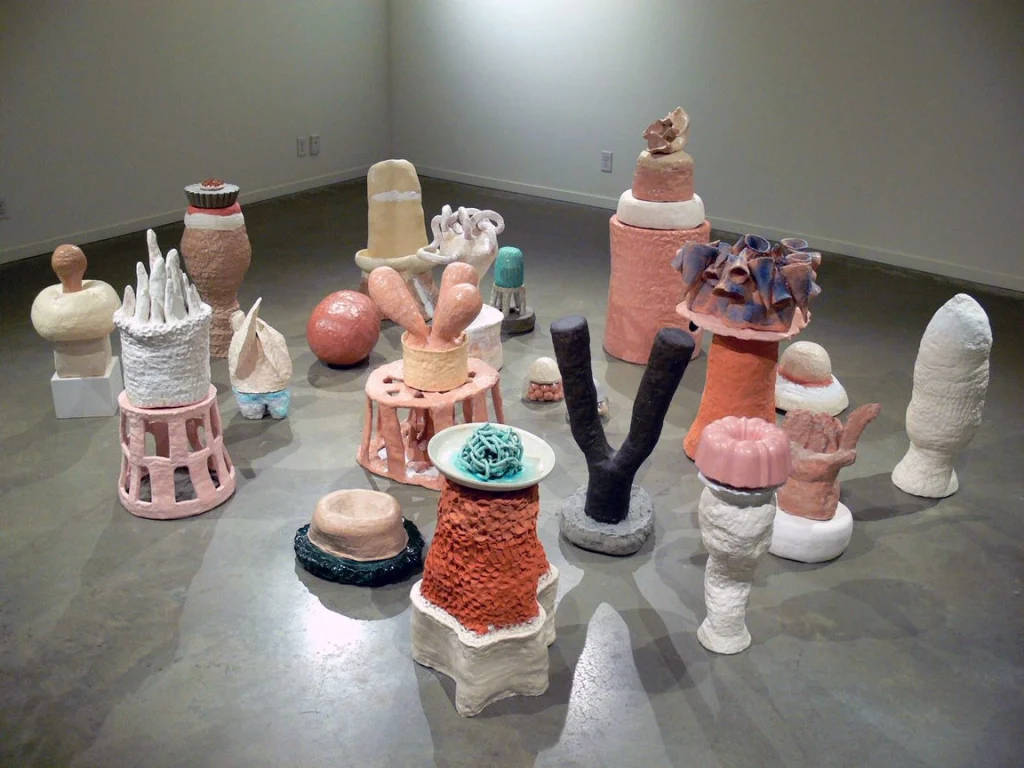Katherine Hoffman: Domiciled
Curated by Jessica Demers
In the creation of this new body of work, Katherine Hofmann put process before product in order to seek an authentic and embodied exploration of materials and form. The resulting sculptures are boldly vulnerable and subtly humorous. Imperfections are celebrated; cracks are roughly filled with plaster to reinforce but not conceal, and the flesh-like masses bear the finger marks of their maker. Forms shift between the human body, plant life and architecture but settle on none, as if work is still in the process of becoming. Sitting on the floor, the sculptures come into direct relationship with our own bodies in the shared space of the gallery.
The rough, seemingly unfinished quality of Hofmann’s work belies her highly developed technical skill with clay, honed over her fourteen year career as a production potter. In 2013, she consciously left her pottery practice in order to return to her earlier interest in sculpture, which was developed during her studies at Emily Carr University in the early 1990s.
The word Domicile refers to one’s country of residence, while the word domestic shares its root, domus, which means home in Latin. Hofmann’s references to domestic life and the body, her use of textiles, and her process-oriented approach echo feminist art practices of the 1960s and 70s. Her work is also akin to post-minimalist sculptors such as the German born American artist Eva Hesse. Both Hofmann and Hesse celebrate the unknown, the absurd and refer to the body with their ambiguous sculptures often made of found materials.
Perhaps Hofmann’s work can be taken as an invitation to accept our own imperfections and explore the possibilities that are created when we let go of our rigid assumptions and expectations. I am curious to see where Hofmann’s exploratory process leads next.
Katherine Hofmann
Katherine Hofmann was born in the Okanagan and has been living in Nelson since 1996. After a short career in Geology and some global travelling, she returned to school to study art at both Emily Carr University and Langara College, and finally, the Kootenay School of the Arts, graduating from the clay studio. In 2013 she received a grant from the Kootenay Columbia Cultural Alliance to make a shift in her creative practice from that of a functional potter to a sculptor.
Artist Statement
This new body of dream–like, and often dome-shaped works meditate upon the conditions of memory, fantasy, identity, and place. Dome structures made of various materials have an historically long architectural lineage. In many cultures, huts were originally dome-shaped, and domes were applied to religious buildings to create a sense of heavenly transcendence. Then there is the obvious shape of the top of our heads. The Latin word domus means house. Perhaps there is a sense of being “home” at a certain point in making when things feel right. During the forming, some plant-like qualities emerged. Planted? Domiciled? Do these ideas merge in the works? Growing like a plant that is rooted in one spot?
My process of making is a well-defined, but intuitive one, which allows each sculpture to have its own internal logic. I cultivate mistakes and not knowing as sources of insight into assumptions. The sculptures have an intentionally raw and rough quality and relate to the human body with surface textures and colours.
The intention with these sculptures is for them to embody the emotional gestures of physical energies. The materials I use are often not “noble” mediums, and as such, the work tends to have a sense of humour. One of my concerns is with how a whole is made up of disparate parts and how each part maintains its identity and individuality even as it is subsumed in a group, cluster, or matrix.




